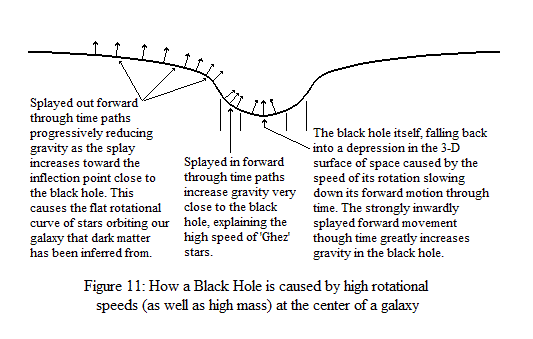Article 17:
How Stationary Energy Theory Explains Black Holes
This is a supplementary article. To go to the main introductory article about Stationary Energy Theory, and its links to other supplementary articles, please click here.
Very massive large objects that are also spinning very fast could well have average rotational speeds well in excess of what would be needed to “flatten” the Universe in their vicinity (for how this happens, see Article 13). They could have sufficient speed to slow down the expansion of the Universe around them so much that the flat spot immediately around them would turn into a concavity (crater), and even into a deep “hole.” The Basic Particles (BPs) of this matter would have their forward paths through time so splayed inward by this that it would increase the force of gravity in the area so it would be far beyond what would be expected from its mass alone. This tremendous gravitational field would suck even light into it, and be a “black hole.” The following diagram explains how this happens:

Using Equation 6 (derived in Article 2 and used determine the size of flat spots on the 'surface' of the universe in Article 13), it can be calculated that if the average rotational speed inside a black hole is only 627 km/s (equal to the overall speed of movement of our galaxy with respect to the CMB rest frame, which it adds to in a complicated way), and the black hole has been forming for one third the age of the universe, then its depth would be around 24,000 light years! (while only being 12 light hours or less wide, in the case of the black hole in our galaxy!) Of course, if it is rotating slower, or is younger, its depth could be a lot shallower, while still being deep enough to greatly increase the force of gravity in and around it. At this average rotational speed of 627 km/s (and assuming it is the the speed at 4 light hours from its center, 2/3 of its maximum possible radius) the rotational period of the the black hole at the center of our galaxy would be 501 days. If the black hole at the center of our galaxy were confined within its Swartzchild radius of about 40 light seconds, and it still had an average rotational speed of 627 km/s, its rotational period would be just under one day (22.3 hrs). Of course, under Stationary Energy Theory the Swartzchild radius has no special relevance, since it is a General Relativity construct, and Stationary Energy Theory stands on its own as an alternative to General Relativity.
The supermassive black hole at the center of our galaxy, and the presumed similar ones in other galaxies, would be good candidates for gaining gravitational field strength through rotation. Since our galaxy rotates, it would not be unreasonable for the mass inside a black hole at the center of it to be rotating. Also, its relatively large size means that its rotational speed (in rpm) could translate into a relatively high actual speed capable of creating a deep concavity where matter would have the inward splay necessary to make gravity hugly stronger than it usually is. This does not preclude, of course, other mechanisms for the formation of black holes that don't involve rotation.
Laura Mersini-Houghton and Harald P. Pfeiffer have recently (in September 2014) published a paper on Laura Mersini-Houghton's work on the stellar-collapse models of black hole formation that claims black holes can't form as a result of stellar collapse, and therefore don't exist! Since there is plenty of evidence that black holes do exist, perhaps they form rotationally in the way Stationary Energy Theory suggests, as outlined in this article (and the next, Article 18), and not through stellar collapse.
Astronomer Andrea Ghez has discovered a number of very young stars orbiting around the center of the galaxy, very close to the center, at very great speeds of about 4% of the speed of light. This would only be possible if there were a huge gravitational attractor, a supermassive black hole, at the center of their orbits. This need not, of course be a black hole caused by stellar collapse, but could be a rotationally caused black hole which would function in the same way as stellar collapse black hole, but would have quite a different structure and path to formation.
To return to where you were in the main article, press your browser's "back" button (<)
To go to the main article on Stationary Energy Theory, please click here.
To go to the next article in the series, Article 18, please click here.